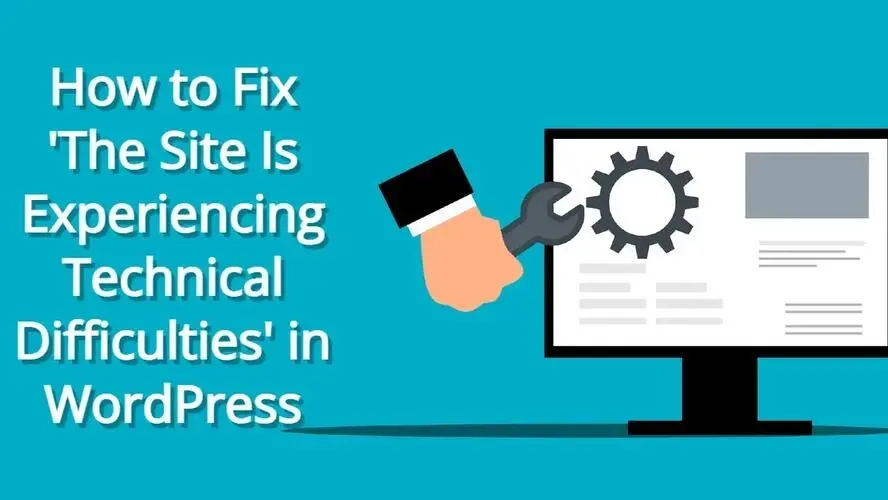Have you ever run into the error “This site is experiencing technical difficulties” in WordPress? If so, until you fix the issue, you won’t be able to view or use your WordPress site. In this article you’ll learn more about this error, as well as how to fix “The site is experiencing technical difficulties” in WordPress.
What is the error “The site is experiencing technical difficulties” in WordPress?
“The site experiencing technical difficulties” in WordPress, represents a nicer version of a fatal error. In older versions of WordPress, most fatal errors resulted either in the website being down, showing a code error, or showing a message indicating what may have triggered the error.
The error looks like one of the two images below:

This is the error message you would see when visiting any of your pages on your site.

This is the error message you would see when visiting the WordPress admin or backend of your website.
If you receive an email, it’s only going to give you the same message. Unfortunately, it won’t tell you where the error occurred so you can fix it.
Possibilities of why the error occurs?
There are a few reasons why you’d get a fatal error or the message that says ‘The site is experiencing technical difficulties” in WordPress:
- WordPress, plugins, or theme failed to update correctly
- Plugin conflict
- Theme conflict
- Malware
WordPress, plugins, or theme failed to update correctly
Sometimes when updating WordPress, even if you’re clicking a button or letting it do an automatic upgrade, things sometimes go wrong. This can also happen when updating your plugins or themes. Technology isn’t always perfect, and these failed updates can result in a fatal error on your website.
Plugin conflict
Some plugins don’t always play well with other plugins. This happens because there are over 60,000 free plugins on WordPress.org’s plugin repository, and thousands of premium paid plugins across the Internet.
Most WordPress plugin developers go by WordPress Coding Standards when building plugins, and test against most of the top most used plugins. They don’t test against every single plugin, so if you’re using a plugin that is newer and may not be used by a lot of people, you could run into conflicts that result in a fatal error.
Theme conflict
Aside from plugin conflicts, you can also have a theme conflict. Most free themes in the WordPress.org theme directory have requirements to meet, in order to successfully be added. However, aside from free themes, there are also paid ones outside of WordPress.org. Not all of them follow WordPress Coding Standards or could ever be submitted to the theme directory.
In some cases, the theme itself may be the problem. In other cases, the theme may not play nice with some plugins. For example, maybe you have a theme that controls a feature, but a plugin is also trying to do the same thing. You may either run into a fatal error, or the feature may not work as expected.
Malware
Malware can cause a fatal error, especially if there is a code or content injection that interferes with WordPress, your plugins, or your theme. Malware usually can be in the form of you being redirected to another site, being prompted to download something, being spammed, and much more.
The malware itself can either be found within your theme’s files, plugins’ files, WordPress core files, and even your database. In some cases, Google Search Console (note: make sure to add your site to Google Search Console) might alert you of malware, if your malware plugin fails to do so.
How to Fix 'The Site Is Experiencing Technical Difficulties' in WordPress
When you go to fix ‘The site is experiencing technical difficulties’ in WordPress, you have to approach it from a few angles:
- Troubleshooting
- Ensuring the integrity of your website
Troubleshooting
In troubleshooting, there’s a couple methods to approach this.
- Email with recovery link
- Manual troubleshoot
Email with recovery link
In most cases, when your site has a fatal error, you should receive an email letting you know what happened, like the image below.
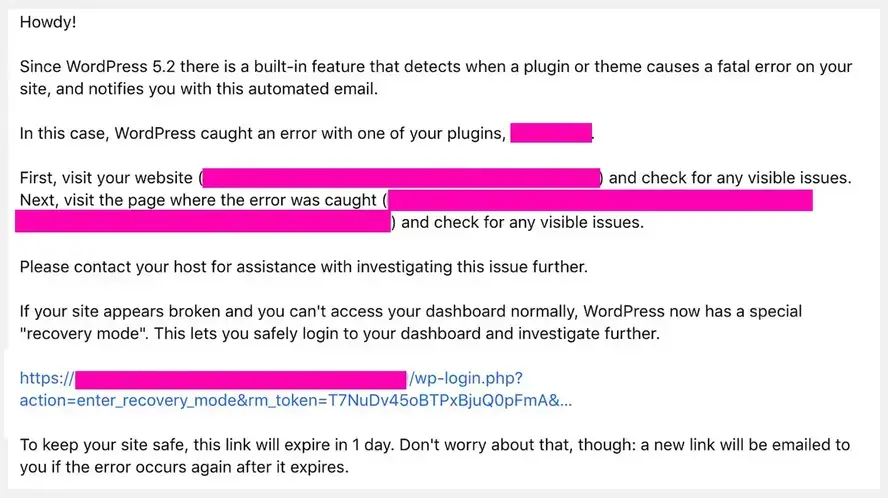
It will tell you if the error came from a plugin or theme, and then give you a link to put your WordPress site in a recovery mode. Now, sometimes the error wasn’t because of the plugin or theme, but that plugin or theme created the error.
Just a note, sometimes you may not even know where to find the problem, and may even not give the email to get your recovery link. Aside from that possible issue, you might not be able to access the backend of your WordPress site. So, in that case, you’re going to have to do a manual troubleshoot.
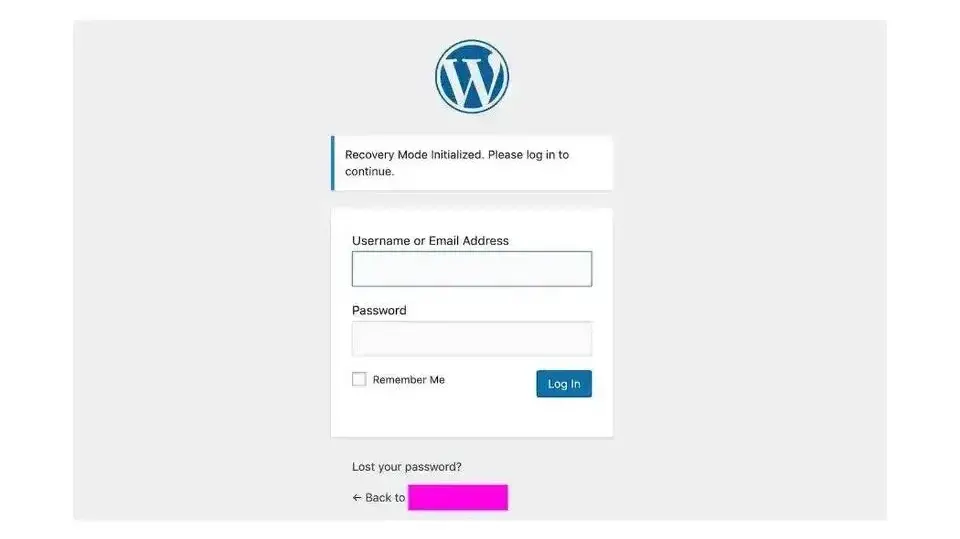
To resolve your error, and you’ve received the email, you will login to WordPress.The recovery mode only allows you to get in and troubleshoot the problem. It doesn’t mean your website is restored. This means that your website visitors will still see an error on their end. When you log into your WordPress admin, during recovery mode, you’ll see the following in your dashboard:
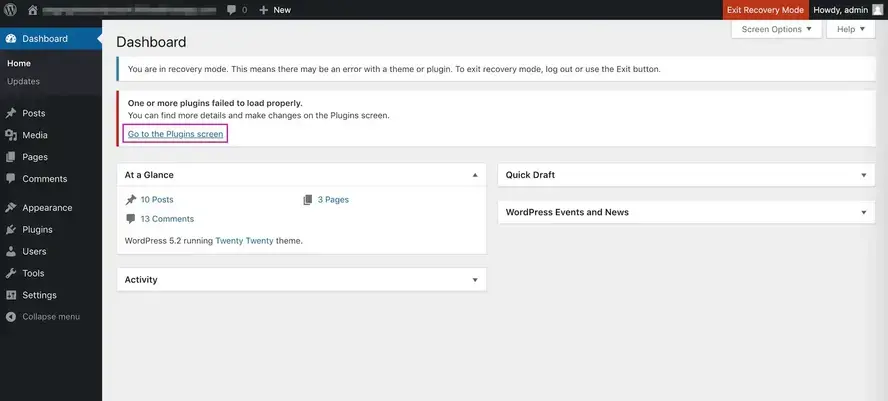
What the recovery mode does, in this case, is “pause” the plugin that WordPress found as causing the fatal error. You’ll go to where all of your install plugins are listed.
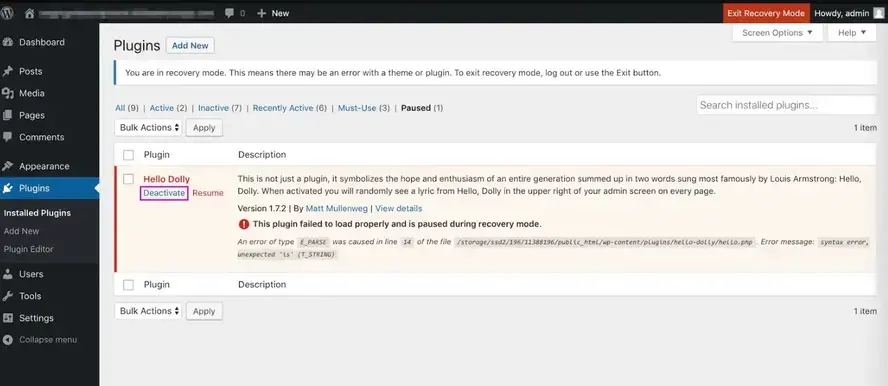
In the case of this article, we’ve found the Hello Dolly plugin as the culprit behind the fatal error. Click the link that says “Deactivate”. When you go to click the Exit Recovery mode at the top, the site should be up and running. If it’s not, then you’ve got more work to do.
Manual troubleshoot
For a lot of people, this might be the most tedious, and it is, but manually troubleshooting WordPress using FTP will get you the answer you need in order to get your site working again. Here are the steps to manually troubleshooting WordPress:
- Navigate to your wp-content folder using FTP.
- Rename your ‘plugins’ folder to ‘plugins-old’.
- Create a new folder with the name ‘plugins’.
- Visit your WordPress backend, and login to check to make sure there are no plugins.
- Remove the empty plugins folder and rename the plugins-old folder back to plugins.
- Go to your plugins list in your WordPress admin.
- Reactivate each plugin one-by-one.
- Remove or leave the faulty plugin deactivated.
Navigate to your wp-content folder using FTP.
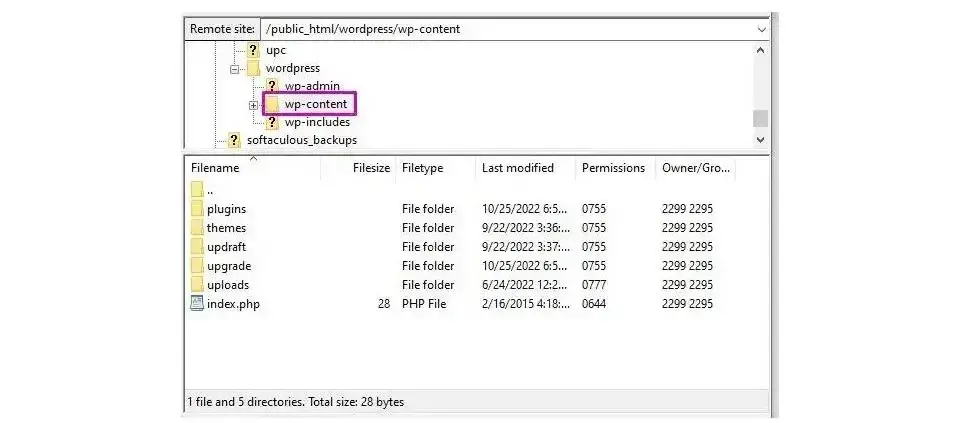
Essentially, the purpose of this is the turn off your active plugins.
As a note, the FTP client used for this article is Filezilla.
Rename your ‘plugins’ folder to ‘plugins-old’.
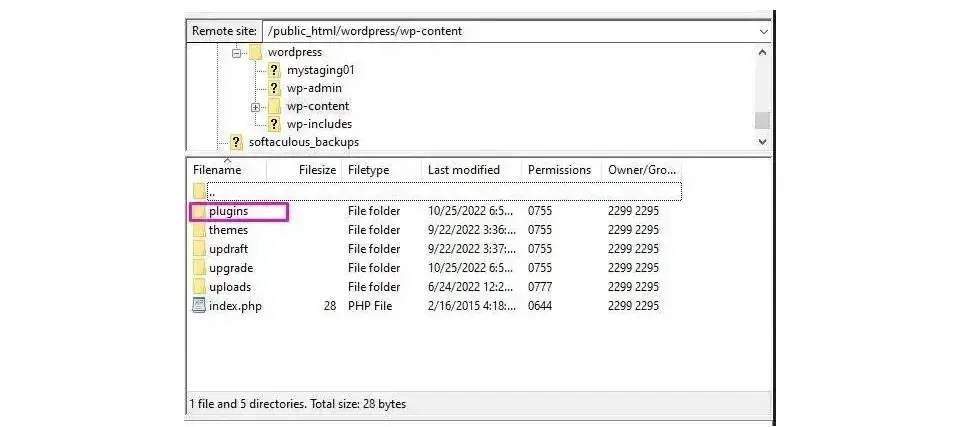
In this step, you’ll be renaming the plugins folder. You can rename it whatever you want, but for this article, we’re naming it ‘plugins-old’. This will turn off the plugins when you visit the site.
Create a new folder with the name ‘plugins’.
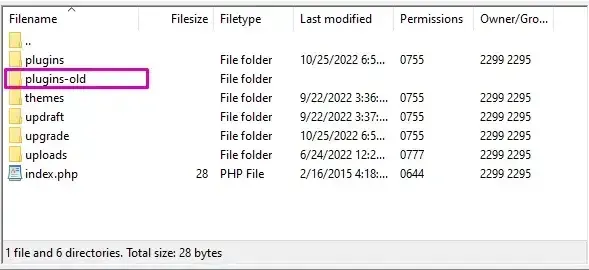
Make sure to create a plugins folder before you go to the WordPress backend of your site. Both plugins and plugins-old should exist in your FTP. The plugins folder will be empty.
Visit your WordPress backend, and login to check to make sure there are no plugins.
Now that you have renamed your plugins to plugins-old, and then created an empty folder named plugins, when you visit your WordPress backend, and navigate to the Plugins area, no plugins should be listed. This is where you know the plugins are officially deactivated. However, you need those deactivated plugins to show, so you need to go back to your FTP account.
Remove the empty plugins folder and rename the plugins-old folder back to plugins.
Go to your wp-content folder again, and remove the empty plugins folder. Make sure it is ‘plugins’ and not ‘plugins-old’. Rename the ‘plugins-old’ folder back to ‘plugins’. You need those plugins to show up in your WordPress admin after this step.
Go to your Plugins area in your WordPress admin.
All of your plugins should be deactivated. Don’t panic if your site looks weird. In fact, ignore it, as hopefully with this whole process, you should have your site working shortly.
Reactivate each plugin one-by-one.
Go ahead and activate each plugin one-by-one. After you activate the plugin, make sure no errors happen. If you get the screen ‘The site is experiencing technical difficulties” in WordPress, then that plugin was probably the problem.
You can deactivate that plugin by going to your FTP client, and finding the plugin in your ‘plugins’ folder. Rename that plugin by adding a suffix like ‘-old’ at the end. Your error in your WordPress admin should go away.
Remove or leave the faulty plugin deactivated.
If the plugin that caused the issue is one that you don’t use, just delete it. In the case you really need the plugin, you might want to let the plugin developer know about the error. However, if you can’t get a timely response, you may either need to hire a developer, or replace the plugin with one that has similar features.
In the case that none of the plugins were the issue, you should try switching your theme to a default WordPress theme like Twenty Twenty-Two.
Ensuring the integrity of your website
Once you’ve restored your site, as a precaution, to ensure that your site’s files are clean and free of possible malware, you need to use a malware scanner. If your site is clean, you don’t have to do much else except backup your WordPress website. If your site has been hacked and has malware, you’ll need to clean where the infection is located. If the infection is left, you could end up with the same fatal error issue, or worse.
In Summary
Now that you know how to fix “The site is experiencing technical difficulties” in WordPress, it’s time to start troubleshooting the issue. Once you’ve fixed the problem, make sure to backup your WordPress site. This will allow you to restore your website back to a fully functional state, in case the error occurs again.
Frequently Asked Questions
Is WordPress free?
All you need to do to use WordPress is to invest in a web hosting plan since the software itself is free.
What is hosting for WordPress?
Hosting for WordPress involves housing your website on servers dedicated to CMS WordPress. You can learn more about hosting for WordPress on our blog.
Are WordPress plugins free?
WordPress has loads of plugins you can install, some of them are free, but some of them you will need to pay for. You can learn how to use WordPress Plugins on our blog.
Why choose Verpex for WordPress?
As the leading CMS out there, we’ve made it our mission to offer the most comprehensive and streamlined WordPress solutions on the market. Backed by a responsive customer care team and reliable site enhancement tools, we ensure our users get the full WordPress value and support for a reasonable price.

Nile Flores is a long time professional blogger, as well as WordPress website designer and developer from the St. Louis Metro East. Nile blogs at NileFlores.com, where she’s passionate about helping website owners, whether they’re small business owners or bloggers. She teaches about Blogging, Social Media, Search Engine Optimization, Website Design, and WordPress. Additionally, Nile loves to speak at WordCamps (WordPress conferences) across the United States. When Nile isn’t knee-deep in coding, she’s a proud mom of a college student, and enjoys oil painting, cigar smoking, nail art design, and practicing traditional Okinawan kempo karate.
View all posts by Nile Flores















